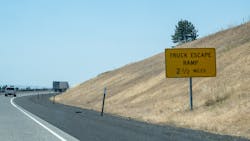Nominations for this year’s Truckload Carriers Association Fleet Safety Awards are now open, and fleets would be best served to heed advice from previous years’ winners, whether they’re looking to enter the contest or simply reduce downtime and prevent crashes.
Two safety experts—Jeff Davis, who is VP of safety at Napa River Insurance Services, and John Simms, senior risk adviser at HNI Risk Services—analyzed recent Fleet Safety Awards winners to find the common denominators among the industry’s safest carriers.
See also: TCA honors North America’s safest fleets
Davis and Simms offered their advice to fleets during a TCA webinar, noting that the advice they gave was not ranked in order of importance.
“Ranking a one through 10 was literally impossible,” Simms said. No. 10 could be No. 1. No. 5 should be No. 1.”
10. Safety is a priority value, and everybody is involved.
A priority is important, but a value is something that’s never compromised, Simms said. Safety is an ever-present principle that tells workers what they must do and who they should be. The best fleets realize that profit does not come at the expense of safety but as a result of it.
9. Incentives foster a competitive spirit
Many fleets have safety incentives—so many extra cents per mile for a clean driving record—but what stuck out about fleets that won the TCA’s Fleet Safety Awards, Davis said, is that their incentive programs brought out a competitive spirit in employees.
Because safety is such a core value to the carrier, drivers, safety managers, and even operations people within the organization compete to get safety numbers down. Additionally, safety incentives are changed periodically, so employees still see them as achievements and not simply cents on the mile that are an expected part of their salary. Simms said he has seen some carriers break drivers into teams and compete to see who can most improve their key performance indicators.
8. All crashes are a big deal
All collisions, even those that aren’t DOT recordable, are investigated seriously.
Close calls identified through technology are also looked at as potential crashes, and the results of those investigations are shared with the entire fleet. During their safety reviews, fleets will also use technology to examine the driver’s behavior not only at the time of the collision but also for the six months before the collision to identify and correct behaviors that could have led to the mishap.
“Frequency leads to severity,” Simms said. Even cutting a corner and rolling over some grass is something worth investigating for these fleets.
7. Getting drivers home …
TCA Fleet Safety Award winners commonly ensure that their drivers receive enough time at home to rest and recuperate so they can return to the job refreshed.
“But one of the things that we found as we dig into it more, it’s not exactly the amount of home time,” Davis said, “but the predictability of home time.” Drivers who can reliably attend family events feel more at home with the company and are more likely to comply with safety regulations.
6. … and giving drivers a home away from home
The fleets strive to create a tight-knit, familial company culture and high quality of life. Ensuring every employee understands the importance of safety is one way to foster this atmosphere. Companies offer health and wellness programs encouraging drivers to stay healthy on the road. Participating carriers encourage employees’ families to watch the Fleet Safety Award livestreams to get involved.
Another way to cultivate a sense of community is for carriers to give back to the community with charitable activities. Fleet Safety Award winners often have programs to give back to local schools and civic organizations.
5. Ongoing educational opportunities
The top fleets consistently provide ongoing training. Drivers are instructed thoroughly on any new safety technologies the fleet decides to incorporate. Drivers are also coached on an individual basis based on their performance data.
4. Empowering drivers
TCA Fleet Safety Awards entrants are categorized as carriers with more or fewer than 25 million miles, and with so much mileage across potentially hundreds of drivers, micromanagement becomes both inadvisable and unfeasible. Carriers should empower their drivers, trusting them to do what’s best without needing to be told to do so. The drivers feel respected and take ownership of their positions, adding to trust in the company, which contributes to a trusting safety culture.
3. Utilizing technology
Incorporating the latest technology is all well and good, but collecting data is pointless if you don’t use it to coach drivers. Good use of telematics data can correct driver behavior proactively to prevent crashes—rather than merely reviewing data after a collision.
“When we have a bad claim, the first thing that the other side is asking for is telemetric data off of units, and if they can find that we have ignored correcting habits,” Davis said. “They’re going to use that against us, and sometimes those things become the items that we say ‘add zeroes’ to claims.”
2. The safest fleets don’t hire their future problems
For Fleet Safety Award winners, “Hiring standards are set in stone and not negotiable,” Simms said. There are face-to-face interviews with multiple managers. Additionally, all members of the onboarding support staff are empowered to hit the brakes on a new hire if they feel that driver will not meet the fleet’s safety standards.
“They will let the truck sit before they hire a future problem,” Simms said. “It’s a thing where it’s something special to get hired on by these carriers. In a lot of cases, I’m willing to bet these carriers have a waiting list of people trying to get on.”
1. Continuous self-improvement
The most successful fleets are never satisfied with simply maintaining a level of safety.
Simms said the safest fleet owners would look for an additional 3% to 5% of safety improvement every year—and "they realize their past safety performance is an indicator of their future safety performance. So if they’re at a high bar, they want to raise the bar, and they raise that bar every year, which is why you see these owners, or the same owners, on the stage year in and year out, because they truly are the best of the best.”
About the Author
Scott Keith
Scott Keith is a former fleet owner digital editor, who was on staff from 2022 to 2023.

